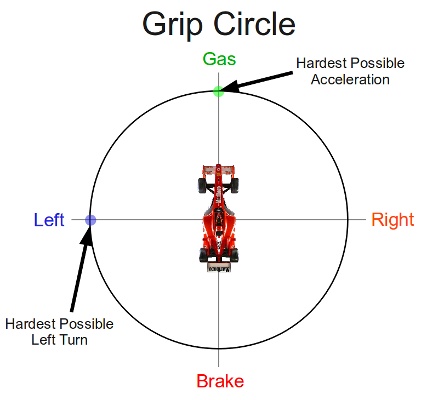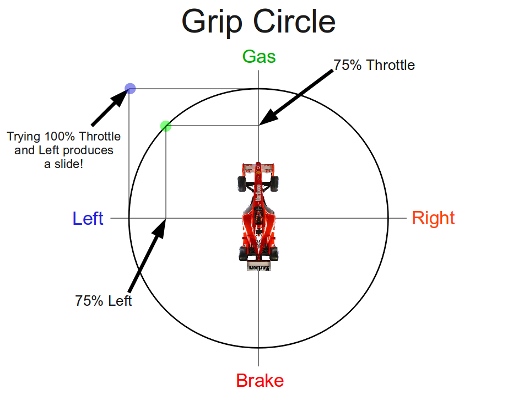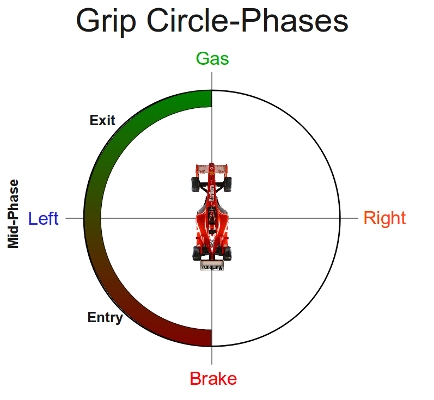The Basic Goal
OK, so you've decided to try and improve the performance of your car.
What does that really mean? What effect are we trying to achieve here?
That may seem like a simple, perhaps even stupid question to ask - except that far too many people dive right in without actually considering what the end state of all this work really is. We need a mission, or a goal, so that we know when it is we are finished, and so we can map a course to get from where we are, at the start, to that final goal.
The ultimate effect should be "win races" - and that implies completing the event course in the shortest possible time relative to the other competitors.
But what does that entail? What does "covering the course in the shortest possible time" involve?
A decent first crack at defining the answer might be something like this:
- The car must gain speed (accelerate) as quickly as possible;
- The car must go around a corner as quickly as possible; and
- The car must lose speed (deaccelerate) as quickly as possible.
Let's examine each of those goals in turn.
- The car must accelerate as quickly as possible. This is immediately obvious to anyone who has participated in a drag race. Given a straight line, and no artificial limit on top speed, he who gains speed the quickest covers the ground in the least amount of time and so gets to the finish line first and wins the race.
- The car must go around a corner as quickly as possible. Intuitively, we know that there is a speed at which one can negotiate a corner without sliding off of it or spinning out. The higher that speed is, the faster we cover the ground in the corner and the less we have to slow down before entering the corner.
- The car must deaccelerate as quickly as possible. Given that we may have to slow down to our maximum cornering speed before entering a corner, the faster we can slow down, the longer we can stay going fast before having to start slowing down. It may seem counter-intuative at first that being able to stop quickly makes you faster, but think of it as playing "chicken" with the corner - the faster the car slows down, the later you can wait before you have to slow down.
Speed up, turn, slow down - seems simple, doesn't it?
It isn't.
Part of the problem is that the car almost never does one of those three tasks in isolation. Very rarely are you just speeding up, slowing down, or turning - there is usually an element of either speeding up or slowing down in conjunction with a turn.
But the other part of the problem has to do with exactly what "speeding up", "slowing down", and "turning" really means.
All three of these actions require the car to exert force on the road surface, and the interface between the car and the road surface is the tire. Whenever we talk about "speeding up", "slowing down", or "turning" what we mean by that is getting those four tires to generate force - forwards, backwards, or sideways. We call the ability to transmit force to the road surface GRIP.
Physics time. The basic equation we are talking about here is:
Speeding up, slowing down, and turning are all accelerations. The car (and driver) have mass. Therefore, in order to produce larger accelerations - which make us faster so we can win races - we need more force, or grip.
If we pretend for a moment that we don't have the ability to change the physical properties of the tires we use (which really isn't that too far removed from reality, given that there is usually a "best tire" and we had better be using it if we want to win) maximizing our ability to speed up, slow down, and turn is really about maximizing grip. Each tire can produce a certain maximum amount of grip before it lets go and starts sliding, and what we want to do is make sure that tire is producing its maximum grip so we can use it to accelerate the car.
(We can also reduce the mass of the car/driver, but for now we'll assume the rules stipulate a minimum weight - as they usually do - and that we are already there)
There are two aspects to maximizing grip: firstly, changing the physical setup of the car to produce the maximum grip level possible, and secondly, making maximum use of that grip.
But remember - we have four tires, not just one. It's not enough to maximize the grip out of any one tire; we have to consider all four tires as a system, not just as individual tires.
And we have to do this while the car is:
- Accelerating in a straight line;
- Deaccelerating in a straight line;
- Deaccelerating and turning;
- Just turning;
- Accelerating and turning; and
- Back to accelerating again.
Complex, neh?
Thankfully, there is a way to simplify how to represent these steps.
The Phases of a Corner
We can break any corner down into three distinct phases:
- Corner Entry in which the car transitions from 100% braking, through some degree of cornering and braking at the same time, to 100% cornering;
- Mid-Phase in which the car is just cornering; and
- Corner Exit in which the car transitions from some degree of cornering and accelerating at the same time to 100% acceleration.

Every race course is a succession of these three phases chained together: entry, mid, exit, entry, mid, exit over and over again. Depending on the design of the course and the shape of the corner, these phases will have different durations and different directions, but it is always entry, mid, exit.
So then, here is our goal:
Goal: Maximize Grip in each of the Entry, Mid, and Exit Phases of a Corner
Everything else that this book talks about is how to achieve this goal. We have four tires. They are all we have to create accelerations on the car. The larger those accelerations, the faster we go, and the faster we go, the more likely we are to win.
There is a way to graphically represent this, and it is very useful to help conceptualize this goal. It is called the "traction circle' or "friction circle" in most literature, but I like to call it the GRIP CIRCLE.

The Grip Circle is a graphical representation of the maximum amount of grip that the car is capable of generating. If you plot an X-Y graph with the car at the origin, the circle around the car represents the maximum amount of grip the tires produce. Where the circle cuts the positive Y axis is the point of maximum acceleration, the intersection of the circle and the negative X axis is the point of maximum left turn, and so on and so forth.
This "circle" absolutely exists. Its actual shape varies somewhat from car to car, as the tires and suspension may favour acceleration/braking over cornering (or vice versa) producing a Grip Circle that is slightly "squashed". But notwithstanding perfectly circular or not, that line represents the transition from "I've got it" to "It's got me" - any point inside the circle, and the car is gripping; any point outside the circle, and the car is sliding.
This is easy enough to visualize in the pure, single-direction case (ie, full braking) but look at the implications for when we combine left/right with gas/brake:

We can't make use of 100% throttle and 100% cornering, because if you extend the lines to their intersection you wind up outside the Grip Circle. If, instead, you start with a point on the grip circle and extend the lines back to the axis, you can see how much of each you can use simultaneously.
Where this gets interesting is in the areas near the maximum extremes. If you are absolutely on the limit cornering, then any throttle or brake input will take you outside the grip limit and start the car sliding. But as the steering wheel is unwound (and so less cornering force is required) then room is created to feed in throttle. The opposite happens during braking: you can be at 100% braking in a straight line, but as you start turning in, you have to release the brake proportional to the amount of steering being fed in.
In an ideal case, the driver will always operate directly on the edge of the Grip Circle - this utilizes the maximum amount of grip and results in the fastest time. In practice, this is easier said than done, especially when the corners follow each other in such rapid succession as they do in an autocross.

Relating the Grip Circle back to the Phases of a Corner, we can see how each corner phase maps onto the Grip Circle.

This is actual accelerometer data for my car on run 12 of the 2004 Peru Pro, plotted XY in order to produce a Grip Circle. Here you can see the "squashed" nature of a live Grip Circle, plus the graph has a "stem" on the positive Y axis because it takes a very high horsepower car to "fill in the corners". But the circle is clearly visible.
It is the Driver's job to drive the car as closely as possible right on the Grip Circle. It is the Engineer's job to make the diameter of the Grip Circle as large as possible, and to set the balance of the car so that the driver can reach all portions of the Grip Circle without the car either plowing or spinning off course.
The rest of this book is going to be about how to meet one of these two goals:
- Enlarge the Grip Circle; and
- Balance the Car
The purpose of both of which is to maximize grip, and with it, lower times - and win!

 The Driver
The Driver

